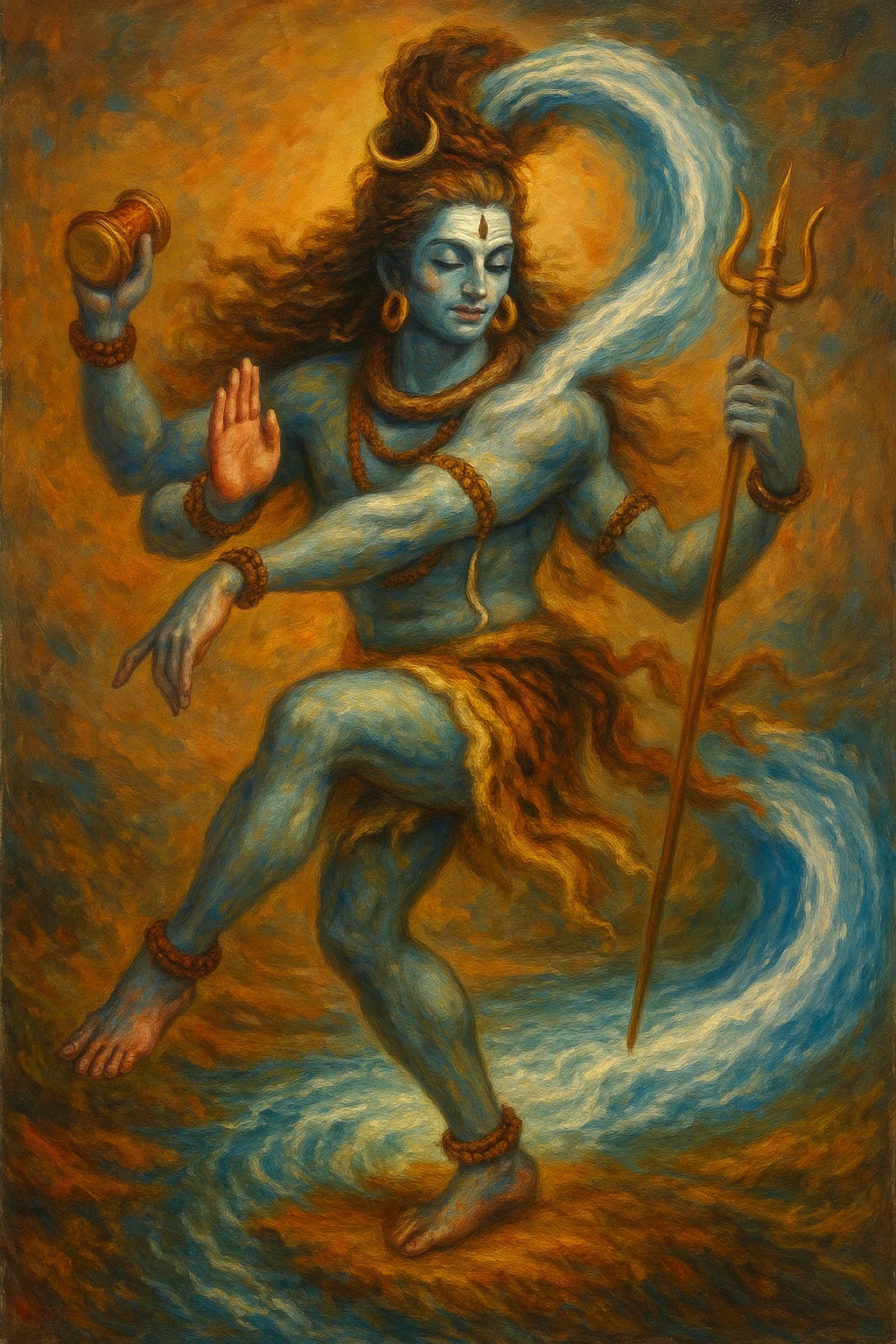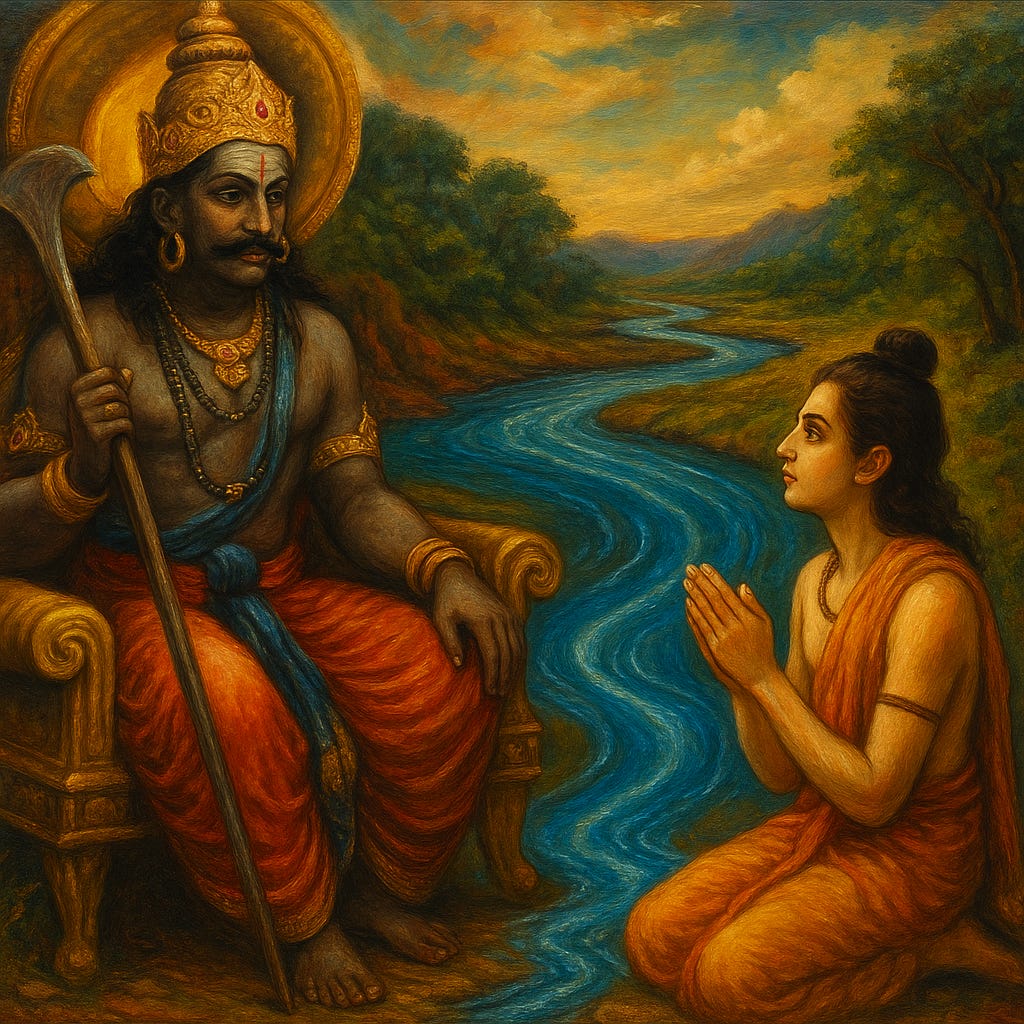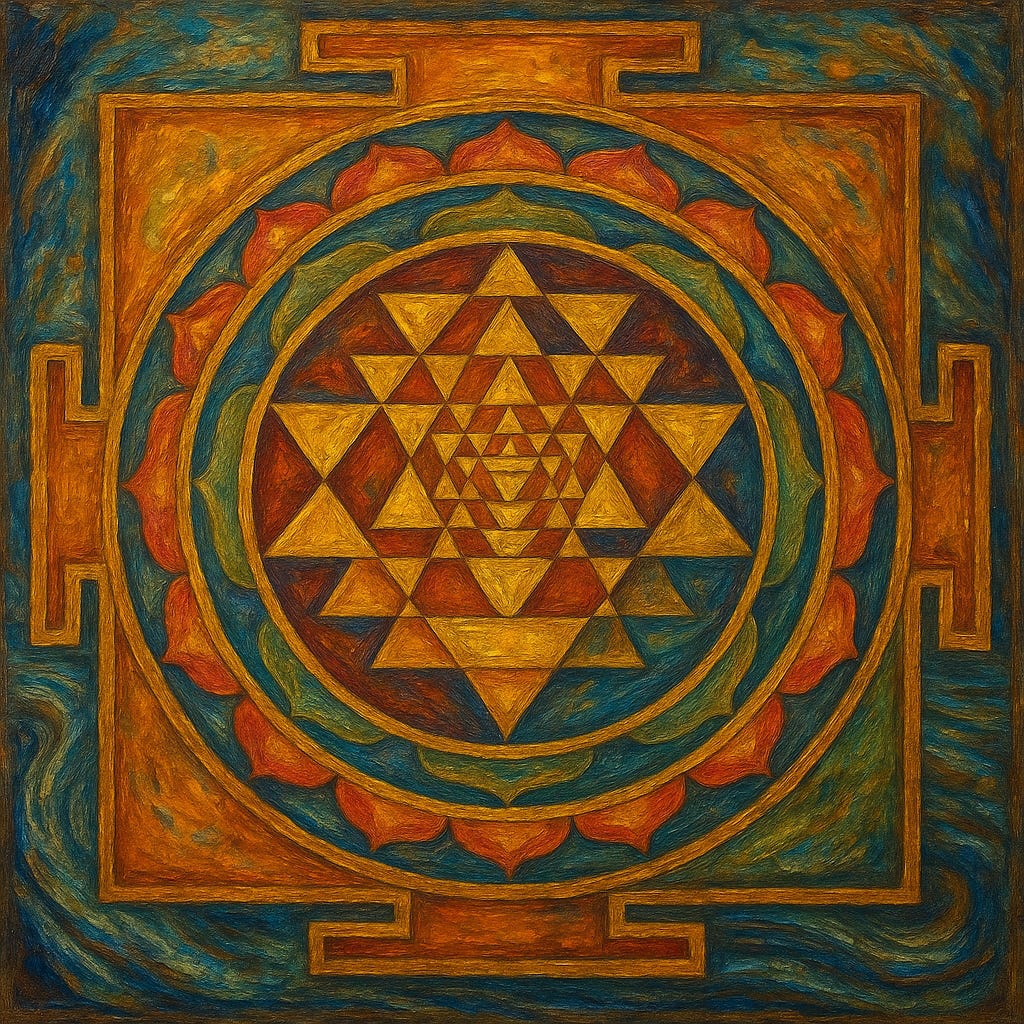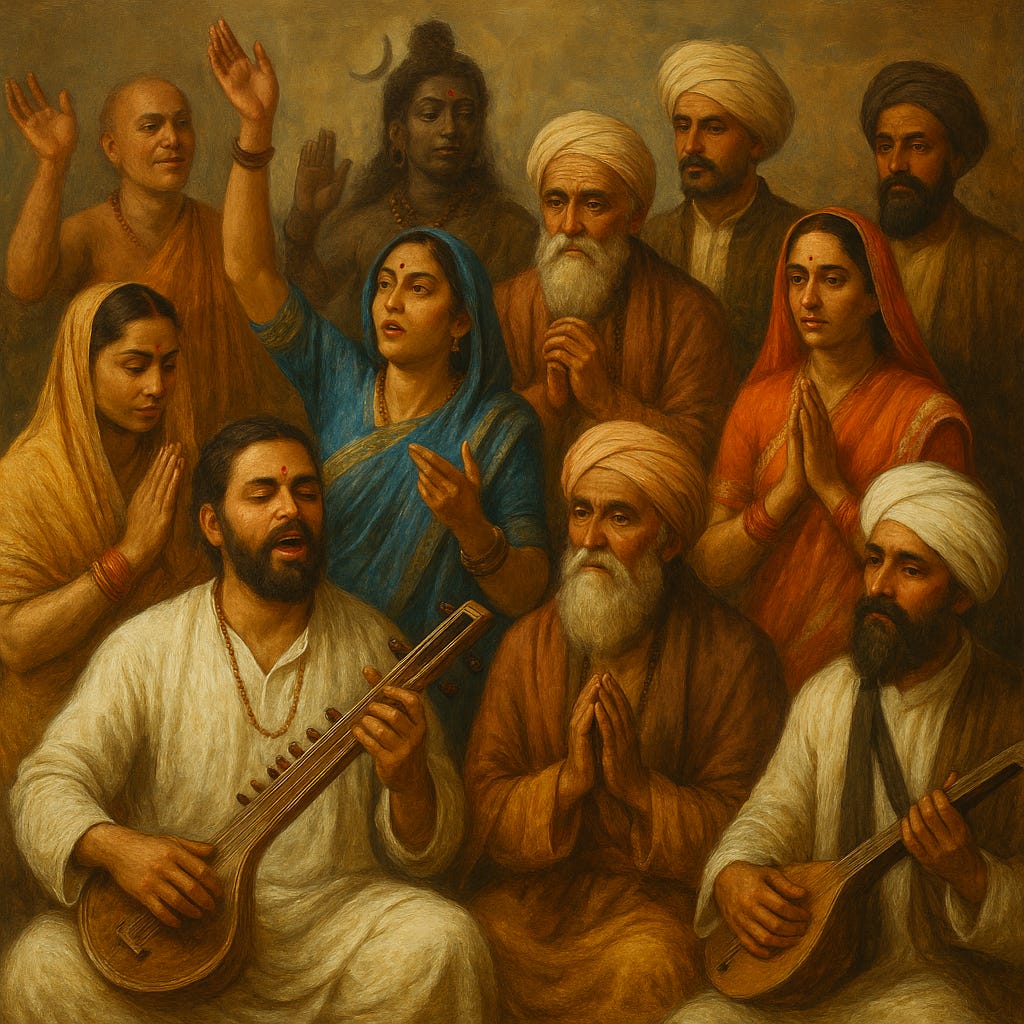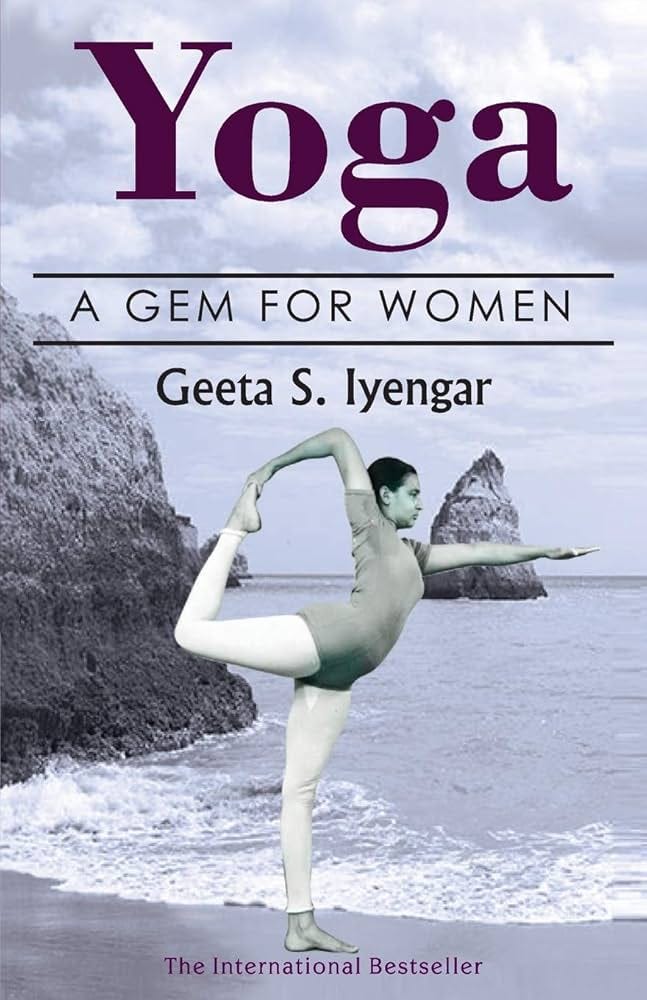Part II – The River of Yoga: Exploring the Inner Currents of Yogic Traditions
Exploring the philosophical currents and spiritual lineages that shape the inner journey of yoga.
The sacred river of yoga has many layers
In the previous article, A Journey Through Time, Thought, and Transformation, we explored how the sacred river of Yoga began as a quiet spring in the ancient Ṛgveda, the earliest of the Vedas. We traced its journey through centuries of wisdom, ritual, and devotion, widening and deepening as it flowed through cultures and continents.
In this article, we dive beneath the surface to explore the river’s inner currents, the traditions, philosophies, and practices that shape the journey of yoga.
Every river has a source. If we look not just through history, but inward, we arrive at an origin more mythical and symbolic: Lord Śiva, the Ādiguru: the first yogi and the first teacher.
Śiva and the Descent of the Sacred River
In Yogic iconography, this river takes a visible form, flowing from the matted locks of Lord Śiva. The river Gaṅgā’s descent through his hair symbolizes not only the taming of divine energy but also Śiva’s role as Ādiguru, the first Guru, who channeled the vast current of yoga into a form that humanity could receive. Yoga, in this vision, is a sacred current revealed, received, and passed on.
As we turn towards these inner currents, we begin to notice new channels branching off: Bhakti, Karma, Jñāna, Haṭha, Rāja, each offering a distinct flavor yet all flowing from the same source. This river winds through the hymns of the four Vedas, deepens in the contemplative stillness of the Principal Upanishads, and branches into the six Darśanas, each offering a unique philosophical lens. It then flows through diverse streams of thought, from the many schools of Vedānta to the transformative practices of Tantra, from the devotional surrender of Bhakti Yoga to the disciplined force of Haṭha Yoga to the inner techniques of Kriya Yoga.
We will explore Yoga as it enters into conversation with modern science and artificial intelligence. Let us dive into these inner currents one by one, tracing how each shapes the evolving landscape of yoga.
The River's Early Course: Yoga in the Indus Valley
The earliest visible bend in the river of yoga appears in the Sindhu-Sarasvatī (Indus Valley) civilization (c. 3000–1900 BCE), one of the world’s oldest urban cultures. It is fitting and almost poetic that this ancient current first took form along the banks of the Indus River itself. Like all rivers, the Indus nourished life: offering water, food, trade routes, and fertile soil.
But alongside this material flow, there was also a spiritual undercurrent. Archaeological findings, including seals depicting figures in seated postures with crossed legs and upright spines, suggest early meditative or ritual practices.
From Seal to Seat: The Timeless Current of Yoga
On the left, the Pashupati Seal (c. 2500 BCE) from the Indus Valley Civilization, widely regarded as the earliest known depiction of Śiva, shows a meditative figure seated in Mūlabandhāsana, suggesting early yogic awareness.
On the right, B.K.S. Iyengar (c. 1960 CE) demonstrates the same posture with modern clarity. Across nearly 4,500 years, the stream of yoga continues, ever ancient, ever alive.
From there, the river of yoga draws nourishment from the Vedas (c. 1500–800 BCE) and early Upaniṣads which begin to explore the subtleties of consciousness, the mind, and ultimate truth.
The River of Revelation: Vedas and Their Inner Currents
As Yoga enters the Vedic age, it deepens into revelation, flowing through hymns, rituals, and philosophy. In the next section, we follow this sacred river through the Four Vedas and their inner layers.
The Four Vedas: Streams of Sacred Knowledge
Each Veda is like a stream feeding into the larger river of yoga, each carrying its own current of wisdom:
Ṛgveda – The Chanting Stream (c. 1500–1200 BCE)
Mountain spring of devotion.
Hymns invoking the divine through poetic vision.Sāmaveda – The Melodic Stream (c. 1200–1000 BCE)
Rippling sound of water.
Mantras merging vibration with consciousness.Yajurveda – The Ritual Stream (c. 1200–800 BCE)
River of sacred order.
Rituals shaping discipline and spiritual action.Atharvaveda – The Practical Stream (c. 1000–800 BCE)
Floodplain of wisdom.
Chants offering healing, protection, and daily insight.
The Four Currents Within: From Surface Flow to Sacred Depth
Like a river with hidden currents beneath its surface, each Veda contains four inner layers, moving from outer forms of worship to inner realization:
Saṁhitā – The Surface Flow
Sunlit waters of sound.
Mantras and hymns invoking the gods with devotion and order.Brāhmaṇa – The Ritual Current
Currents beneath the surface.
Guiding sacred rites and shaping ritual precision.Āraṇyaka – The Forest Undercurrent
Hidden streams of solitude.
Wisdom composed in silence, nourishing reflection and inner stillness.Upaniṣad – The Deep Still Waters
Waters of silent depth.
Revealing the unity of Ātman and Brahman, self and source.
Reflecting Pools of Truth: The Upaniṣads
As the river of yoga matured, it flowed into reflective pools, quiet spaces where seekers gazed deeply into the nature of reality. These are the Ten Principal Upaniṣads, luminous texts that distill Vedic wisdom into focused inquiries on identity, truth, and liberation.
Like still waters that reflect the sky, these Upaniṣads became mirrors of the Self, inviting the yogic gaze inward. Though composed by different sages in different regions, they all reveal the same truth: you are that eternal consciousness.
Īśa Upaniṣad (c. 800–600 BCE)
A short and luminous stream.
It declares the divine presence in all things, blending action with inner renunciation.Kena Upaniṣad (c. 800–600 BCE)
A probing current that questions the seen and the unseen.
It asks: Who directs the mind? Who moves the breath? Pointing to the source behind all experience.Kaṭha Upaniṣad (c. 700–500 BCE)
A deep and mythic river.
The boy Naciketas meets Yama, the Lord of Death, and learns of the eternal Self beyond death.Praśna Upaniṣad (c. 600–400 BCE)
A dialogic stream of inquiry.
Six seekers pose six questions, unfolding layers of life and consciousness.Muṇḍaka Upaniṣad (c. 600–400 BCE)
A river forking into two paths.
It distinguishes higher knowledge that liberates from lower knowledge that informs.Māṇḍūkya Upaniṣad (c. 500–300 BCE)
A concise but potent stream.
It explores Oṁ and the four states of consciousness, culminating in silent stillness.Taittirīya Upaniṣad (c. 700–500 BCE)
A layered flow of self-exploration.
It unveils the five sheaths (kośas), from body to bliss.Aitareya Upaniṣad (c. 700–500 BCE)
A visionary current of origin.
It contemplates creation, consciousness, and the Self as the cosmic source.Chāndogya Upaniṣad (c. 800–600 BCE)
An expansive river of teachings.
It weaves stories, parables, and the refrain "Tat tvam asi" — That Thou Art.Bṛhadāraṇyaka Upaniṣad (c. 800–600 BCE)
A vast, oceanic current.
It engages deep inquiry into the Self, truth, and ultimate liberation.
These Upaniṣads became the still waters in which ancient India saw its deepest reflections.
Nachiketa at the River of Death: The Boy Who Questioned Yama
Drawn from the Kaṭha Upaniṣad, this scene depicts young Nachiketa, who journeyed to the house of Death and waited three days to meet Yama, the Lord of Death. In this powerful encounter, Nachiketa did not ask for wealth or long life but for knowledge of the eternal Self (Ātman). Here, by the River of Death, their timeless dialogue unfolds, one that reveals the secret of immortality.
Guiding Currents: The Six Streams of Darśana
As the river of yoga continues its journey, it flows through six guiding currents of Indian philosophy known as the Ṣaḍdarśanas, or “six ways of seeing”. Each darśana offers a unique perspective on truth, knowledge, and liberation.
Though only one is formally named Yoga, all six offer tools that deepen yogic inquiry and illuminate the path toward self-realization.
Nyāya – Current of Logic (c. 6th century BCE)
A current of sharp reasoning.
It teaches the seeker to discern truth from illusion through logic and valid means of knowledge (pramāṇa).Vaiśeṣika –Current of Subtle Elements (c. 6th century BCE)
A current mapping the structure of reality.
It breaks existence into atoms and categories, revealing a world of substance, quality, and motion.Sāṅkhya – Current of Dual Insight (c. 5th century BCE)
A current flowing with contrast and clarity.
It distinguishes between Puruṣa (consciousness) and Prakṛti (nature), showing how their separation leads to liberation.Yoga – Current of Inner Discipline (c. 2nd century BCE)
A current of purification and stillness.
Rooted in Patañjali’s Yoga Sūtras, it outlines a path of practice leading toward self-realization.Mīmāṃsā – Current of Sacred Action (c. 4th century BCE)
A current grounded in ritual and dharma.
It upholds the power of Vedic action, aligning precise performance with cosmic harmony.Vedānta – Current of Ultimate Knowledge (c. 2nd century BCE)
A current flowing toward the Absolute.
It reflects on the Upaniṣads’ mahāvākyas, revealing the oneness of Self (Ātman) and Brahman.
Together, these six darśanas form a great confluence of Indian thought, each current flowing toward the same spiritual ocean, each enriching the river of yoga with insight, discipline, and clarity.
Subcurrents of Jñāna: Vedāntic Philosophies
As we delve deeper into the currents of the Vedānta Darśana, we encounter a series of distinct subcurrents, each shaped by different sages, texts, and interpretive lenses. Though they all draw from the same source, the Upaniṣads, they offer varied perspectives on the relationship between Ātman (Self) and Brahman) (Absolute). Some emphasize nonduality, others devotion, and others still a refined dualism.
Advaita Vedānta (c. 8th century CE)
A non-dual subcurrent dissolving into oneness.
The Self (Ātman) is not separate from Brahman; all forms are appearances in Brahman.
Key figure: Ādi Śaṅkarācārya
Brahman (Absolute): The only reality: unchanging, formless, infinite
Ātman (Self): Completely identical with the Absolute (Brahman).
Prakṛti (Nature): Appears real but is an illusion (māyā).
Īśvara (God): A helpful concept for meditation but not separate from the Self.
Viśiṣṭādvaita Vedānta (c. 11th century CE)
A qualified non-dual subcurrent where the soul is a wave within the ocean of God.
The Self remains distinct yet inseparable from the Divine.
Key figure: Rāmānujācārya
Brahman (Absolute): Possesses form and attributes; the indwelling reality
Ātman (Self): Part of Brahman, divine yet dependent
Prakṛti (Nature): Real and a mode of Brahman’s body
Īśvara (God): The personal Supreme, approached through devotion
Dvaita Vedānta (c. 13th century CE)
A dualist subcurrent where two rivers flow side by side, never merging.
The soul and God remain eternally distinct.
Key figure: Madhvācārya
Brahman (Absolute): The personal, supreme God with separate existence
Ātman (Self): An independent soul, distinct from God
Prakṛti (Nature): Real and created by God
Īśvara (God): The Supreme Being: loving, powerful, and the object of surrender
These are the three principal subcurrents of Vedānta. However, other significant currents also flow within this vast tradition, including Bhedābheda (difference and non-difference), Śuddhādvaita (pure non-dualism), and Acintyabhedābheda (inconceivable oneness and difference), each offering unique theological and philosophical insights.
For over a thousand years, these subcurrents have engaged in deep philosophical debates: interpreting, defending, and critiquing one another’s views with precision and rigor. The Brahma Sūtras, along with their bhāṣyas (commentaries), serve as the central ground for these dialogues, providing the shared foundation upon which each subcurrent builds its vision of the Self, the Divine, and ultimate reality.
The Tantric Turn: Awakening the Subtle Currents
After the philosophical heights of Vedānta, the river of yoga bends inward descending into the sacred geography of the body, energy, and sound. This is the turn toward Tantra (c. 6th–13th century CE): a rich, multifaceted tradition that views the body as a sacred vessel through which the infinite is both concealed and revealed.
Tantra weaves together cosmology, ritual, breathwork, visualization, mantra, and meditation into an integrated spiritual path. Its influence spreads across Śaiva, Śākta, Vaiṣṇava, and even Buddhist traditions, each developing its own streams of tantric practice and insight.
Tantra sees divinity in every aspect of embodied life: the five elements, the breath, the senses, even the passions, and seeks to transmute them through awareness and practice.
Key Elements of Tantra:
Kuṇḍalinī Śkti
An underground spring coiled at the base of the spine.
Its ascent through the cakras awakens higher states of consciousness.Cakras and Nāḍīs
A branching river of energy channels and centers within the body.
Prāṇa flows through these subtle paths, vitalizing the inner system.
Mantra and Sound
A resonant current vibrating through sacred syllables.
These sounds tune the seeker to deeper levels of awareness.Mudrās and Bandhas
Currents shaped by inner gestures and energetic locks.
They redirect the flow of subtle energy with precision and control.Maṇḍalas and Visualization
Circular currents mapping the terrain of consciousness.
These symbols guide the mind inward toward the sacred center.Initiation and Guru-Disciple Transmission
A hidden stream flowing through lineage.
Direct transmission awakens the path through the teacher’s grace.
The Spiral Stream of the Divine Feminine
Among Tantra’s most mysterious streams are the 64 Yoginīs, fierce and liberating female energies worshipped in ancient, open-roofed circular temples such as those in Hirapur and Khajuraho. These temples honor the divine feminine as both fierce and wise, reminding the seeker that awakening is a spiral dance with nature, instinct, and the cosmos. Here, the feminine is not subordinate but sovereign, guardian of transformation and protector of the sacred.
Kashmir Śaivism: Flowing Toward the Infinite
One of Tantra’s deepest streams is Kashmir Śaivism (9th–11th century CE), shaped by the teachings of Abhinavagupta. At its core is Pratyabhijñā, or recognition: the insight that the Self is already the infinite Śiva, simply forgotten.
In his Tantrāloka, Abhinavagupta described 112 experiential methods such as mantra, breath, awareness, visualization, drawn from the Vijñāna-Bhairava Tantra. These are gateways leading the yogi into the flowing river of consciousness and its vast source.
Tantra’s honoring of Śakti also opened space for women seekers. The river carried voices like Lallā of Kashmir and Akka Mahādēvī of Karnataka, mystic poets who helped shape and expand the tradition.
The Śrī Yantra: Spiral of the Sacred Current
The Śrī Yantra is a central symbol in Tantra, depicting the union of Śiva and Śakti through nine interlocking triangles centered around the bindu. It is both a cosmic diagram and a meditative gateway, guiding the seeker from the outer world into the still, radiant center of the Self.
The Bhakti Surge: Devotion’s Transforming Flow
As the river of yoga flowed through the medieval heartlands of India, it was Bhakti, the path of devotion, that opened its waters to all. Unlike the exclusive rituals of priestly elites or the solitary heights of philosophers, Bhakti saints brought yoga into temples, streets, and homes through simple songs, ecstatic poetry, and deep surrender to the Divine.
Bhakti dissolved the boundaries of caste, language, and gender. Saints emerged from every region of Bharat, each singing the same truth in different tongues: that the heart is the true altar, and love is the deepest yoga.
Voices of Bhakti from Across the Land:
Tamil Nadu (South)
The Bhakti River surged here, breaking caste and gender banks through fiery hymns.
Āḻvārs and Nāyaṉmārs composed songs that made devotion a living current for all.Karnataka (South)
The river turned revolutionary, cutting through social boundaries with fearless poetry.
Basavanna and Akka Mahādēvī voiced inner freedom through mystical vachanas.Maharashtra (West)
Here the Bhakti stream mingled with daily life like a spring nourishing every field.
Jñāneśvar, Tukārām, and Nāmdev infused Vedāntic wisdom into devotional abhaṅgs.Gujarat (West)
The current meandered joyfully, singing of Kṛṣṇa’s līlā with playful abandon.
Narsinh Mehta and Dādū Dayāl spread love beyond all sectarian divides.Rajasthan (West)
The river sang with passionate defiance, leaving royal walls behind.
Mīrābāī’s songs for Giridhārī echo across centuries as ripples of surrender.Punjab (North)
Bhakti opened new currents of unity and remembrance.
Guru Nānak’s nāma saṅkīrtana became the source of Sikh devotion and equality.Uttar Pradesh (North)
The current flowed between worlds, clear and cutting like a confluence of truths.
Kabīr, the weaver-saint, transcended religious labels to reveal the one Beloved.Bengal (East)
The stream swelled into communal song and ecstatic devotion.
Caitanya Mahāprabhu’s Kṛṣṇa kīrtans turned Bhakti into a tidal wave of longing.Assam (Northeast)
The river merged with local culture, painting Bhakti in vibrant regional hues.
Śaṅkaradeva brought devotion alive through music, drama, and storytelling.
These saints made yoga accessible. Even today, when a kīrtan (devotional song) arises or a mantra is sung with feeling, we are touching the same current that flowed through these mystic hearts.
Rising Waters: The Emergence of Haṭha Yoga
As Tantra’s current deepened, a new stream rose to the surface: Haṭha Yoga, a forceful yet subtle system that treated the body as a sacred vessel of transformation. Where earlier paths often emphasized renunciation and contemplation, Haṭha Yoga used posture, breath, and energetic locks to awaken latent power within.
Rooted in Tantric Śaiva and Śākta traditions, Haṭha Yoga viewed the human system as a microcosm of the universe. Liberation was not an escape from the body but its refinement. The union of Śiva and Śakti became the central motif.
The Nātha Yogis and Living Lineages
At the forefront of Haṭha Yoga’s rise stood the Nātha Yogis, a vibrant, often wandering community of ascetics and practitioners. Their tradition traces back to the mythical sage Dattātreya, regarded as the combined essence of Brahmā, Viṣṇu, and Śiva, and to Śiva Himself as the Ādi Guru.
Matsyendranātha (c. 9th century) and Gorakṣanātha (c. 10th–11th century) carried this stream forward, blending mystical insight with practical methods. Over time, the Nāthas organized into Akhāḍās: monastic brotherhoods that preserved yoga, martial discipline, alchemical knowledge, and spiritual teachings.
They also encoded their wisdom in texts like the Gorakṣa Śataka, Haṭha Yoga Pradīpikā (15th century, by Svātmārāma), and Gheraṇḍa Saṁhitā. These works became manuals for generations of yogis. The body was seen as a pot that must be strenghtened and purified to hold amṛta, the nectar of immortality awakened by yoga.
The Kumbh Mela: A Confluence of Devotion and Humanity
These akhāḍās still gather today at the Kumbha Mela: the largest spiritual gathering on earth, occurring every 12 years at sacred river confluences like Prayagraj, Haridwar, Ujjain, and Nashik.The 2025 Kumbh Mela drew over 400 million pilgrims across 55 days: surpassing the entire population of the United States (350 million). To put that in perspective: imagine the entire U.S. population compressed into a space the size of New York City. That’s the scale of India’s largest spiritual gathering.
Held at the Triveṇī Saṅgam, the sacred meeting point of the rivers: Ganga, Yamuna, and the invisible Saraswati, devotees gathered to bathe in the confluence, an act of deep purification and renewal. The next Kumbha Mela will begin on August 31, 2025, in Nashik, Maharashtra.
At the Kumbh Mela, yogis of every kind emerge from obscurity:
Nāga Sādhus
Like serpent-fish, they glide bare through the current, shedding all worldly skin.
They renounce possessions and clothing, covering themselves in ash and living in fierce detachment from society.Aghoris
Like deep-water eels or river crocodiles, they dwell in the shadowy bends of consciousness.
They embrace what others fear: cemeteries, death, and taboos, as gateways to freedom and transcendence.Dandis, Urdhvavāhīs, Jatādhārīs
These are the upstream swimmers, fish that leap against the current.
Bound by intense vows of silence, standing, or solitude, they practice austere disciplines to transform body and mind.
Akhāḍās trace their roots to Advaita Vedānta, drawing inspiration from Ādi Śaṅkarācārya (8th century CE), who is said to have founded maṭhas (four monastic seats) and sparked reform across diverse spiritual sects.
Haṭha Yoga is often translated as the “yoga of force,” but deeper meanings emerge when we look at the syllables: “ha” representing the sun and “ṭha” the moon. This is not brute force but balance: the union of opposing energies, the synchronization of body and soul.
Hidden Springs: Kriyā Yoga and the Himalayan Flow
Beneath the surface of popular yoga flows a quieter, deeper stream: Kriyā Yoga. Passed down through a secretive Himalayan lineage, it emphasizes inner stillness, breath control, and the awakening of subtle energy. This stream flows not in public spectacle, but in the quiet devotion of those who seek the source.
Mahāvatār Bābājī
The guardian of the hidden source
Revered as a timeless yogi residing in the Himalayas, Bābājī is honored more as a guiding presence than a historical figure—beyond time and form.Lahirī Mahāśaya (1828–1895)
The spring enters daily life
Received direct initiation from Bābājī near Rānikhet. A householder yogi who integrated deep spiritual practice within family and work life.Swāmī Śrī Yukteśwar (1855–1936)
The stream meets science and cosmology
A saint-scientist and astrologer who wrote The Holy Science, aligning yogic wisdom with Vedic cosmology and rational inquiry.Paramahaṁsa Yogananda (1893–1952)
The current flows westward
A disciple of Yukteśwar who brought Kriyā Yoga to the West. His Autobiography of a Yogi became a spiritual classic, inspiring generations of seekers.
Branching Streams: The Rise of Neo-Haṭha Yoga
As the river of yoga entered the 20th century, it branched into new currents: revitalized through tradition yet shaped by modern forces. Nowhere is this more visible than in the lineage of Tirumalai Krishnamacharya, whose influence flows into nearly every modern style of postural yoga.
Tirumalai Krishnamacharya (1888–1989)
Often called the “father of modern yoga,” Krishnamacharya was a scholar, healer, and master of āsana, prāṇāyāma, and Ayurveda. Teaching at the Mysore Palace, he revived Haṭha Yoga by integrating rigorous physical practice with textual wisdom. His journey began with a deep study of ancient texts, including the Yoga Korunta, a lost manuscript said to contain unique sequences and techniques that shaped his approach.Pattabhi Jois (1915–2009)
A student of Krishnamacharya, Jois systematized the Ashtanga Vinyasa Yoga method: a dynamic, breath-linked sequence that emphasized discipline, tapas, and repetition. Like a fast-flowing stream, it gained global popularity and seeded many power yoga traditions.T.K.V. Desikachar (1938–2016)
Son of Krishnamacharya, Desikachar developed Viniyoga, emphasizing individualized, breath-led practice rooted in classical teachings. His river flowed quietly but deeply tailored to the needs of each seeker.B.K.S. Iyengar (1918–2014)
Born into poverty and plagued by tuberculosis, malaria, and typhoid, Iyengar was bedridden and frail as a child. At age 15, he was sent to live with his brother-in-law, Krishnamacharya, in Mysore. There, he began observing yoga classes; too weak to participate, he learned by watching.
Slowly, through self-practice and perseverance, he transformed his broken body into one of immense strength and resilience. Krishnamacharya eventually accepted him as a formal student.Iyengar later moved to Pune, where he established the Ramamani Iyengar Memorial Yoga Institute, named after his late wife. From here, his teachings flowed worldwide. He innovated the use of yoga props: bricks, belts, bolsters, ropes, and trestles, to make the poses accessible to all bodies, refining alignment and deepening awareness.
His daughter Geeta Iyengar, a pioneer in adapting yoga for women’s physiology, authored A Gem for Women. His son Prashant Iyengar continues the lineage with profound philosophical insight. Together, they cultivated a method known for its depth, discipline, and therapeutic potential: like a clear, structured canal that makes the vast current of yoga usable for every seeker.
Modern Variations and Creative Currents
By the early 2000s, the river of yoga had broken its banks, reaching every corner of the world. In this global flow, countless modern forms have emerged: Vinyāsa, Yin Yoga, Hot Yoga, and even more eclectic offshoots like Beer Yoga and Goat Yoga. While these reflect yoga's adaptive nature and global reach, it is vital to remember the source. Yoga is not defined by novelty or spectacle, but by inner transformation. Beneath every variation, the essence remains: union, awareness, and the journey inward.
“Gaining maturity in yoga practice involves learning to respect the paths that other people are on and acknowledging their merits, maybe even acknowledging that your own path is lacking in some area where another one excels.”
— Geeta Iyengar
Expanding Currents: Modern Sages and Global Lineages
Also, in the 20th century, new streams began to flow from the river of yoga. Mystics, saints, and seekers carried its ancient current into uncharted realms. Rooted in tradition, their voices shaped the evolving contours of modern spiritual inquiry.
Śrī Aurobindo (1872–1950)
A visionary tide that lifted yoga toward a new horizon of evolution.
His Pūrṇa Yoga (Integral Yoga) united body, mind, and spirit in a collective ascent toward divine life.Ramaṇa Maharṣi (1879–1950)
A still mountain spring where thought flows back into silence.
He guided seekers inward through Vedāntic inquiry: “Who am I?”, revealing the Self as the ever-present source.J. Kṛṣṇamūrti (1895–1986)
A wind that scattered the silt and broke through the banks.
Rejecting all tradition and method, he invited fresh observation, where truth flows uncontained.Svāmī Śivānanda (1887–1963)
A confluence where multiple currents met and spread outward.
From his Rṣikeśa āśrama emerged teachers and paths that carried yoga across the modern world.Many more joined this stream:
Svāmī Rāma, Ānandamayī Mā, Nīma Karolī Bābā, Rām Dās, Indrā Devī, Svāmī Satyananda Sarasvatī, and others: each a current of devotion, insight, or inspiration feeding the river of yoga’s unfolding.
Modern Confluences: Yoga in the Age of Science and AI
“I think, therefore I am.”
— DescartesWestern philosophy, shaped by Descartes, reinforced a split between mind and matter. His statement made thought the basis of existence. But in yoga, thinking conceals rather than reveals the Self. The true being is not the thinker, but the silent witness behind thought.
Today, modern science is catching up. The “hard problem of consciousness,” coined by philosopher David Chalmers, asks why and how subjective experience arises from neural processes. This challenge has led top researchers at institutions like MIT, Harvard, and Oxford to explore consciousness not just through neuroscience but through contemplative traditions and ancient philosophies.
Quantum physicists are also questioning the fundamental nature of reality: some theories now suggest consciousness may play a central role in collapsing the wave function of potential into observable form.
As the river of yoga flows into the 21st century, it enters into active dialogue with modern science. Medical researchers, using tools like neuroimaging and molecular biology, are beginning to validate the effects long described by yogis. This meeting can be seen as the river of yoga merging with the ocean of empirical inquiry, enriching each other in the process.
Neurological Benefits
Like a river clearing and nourishing its own path, yoga rejuvenates the neural landscape.
Studies using MRI and EEG show that yoga preserves gray matter, boosts neuroplasticity, and strengthens regions tied to memory and emotional balance. A 2023 UCLA study found yoga preserved brain volume in older adults, while the control group declined.Stress and Immunity
Yoga strengthens the inner banks of resilience, slowing the erosive current of chronic stress.
By lowering cortisol and inflammation and balancing the autonomic nervous system, yoga enhances immunity. A 3-month yoga retreat showed increases in BDNF, a protein that supports learning, memory, and emotional resilience, along with drops in inflammatory markers.Mental Health and Well-being
Yoga guides the inner current toward stiller, deeper waters.
Yoga is now used alongside therapy for anxiety, depression, and PTSD. Research shows raised GABA levels, a neurotransmitter that calms neural activity, and structural changes in the hippocampus and prefrontal cortex. Yoga fosters purpose, connection, and calm.Physiological and Biochemical Shifts
Like a life-giving stream, yoga irrigates the body with vitality.
Yoga improves cardiovascular health, posture, and balance, and even shifts gene expression: reducing inflammation and supporting telomere length, reaching into the roots of cellular aging.Yoga and Artificial Intelligence
This is a modern stream entering ancient waters.
In recent years, AI has entered the yoga landscape, offering tools like pose-detection apps, virtual instructors, and personalized practice recommendations based on biometric data. These technologies act like new channels, making the teachings more accessible and scalable. However, while AI can mirror form, it cannot transmit presence. The inner essence of yoga, the flow of praṇic awareness, the spark of transformation, remains beyond algorithmic capture. As yoga meets AI, the challenge is to let this modern stream serve the tradition without diluting its depth.
Other emerging fields include:
Neurophenomenology
Like two rivers meeting: subjective experience and objective science merge.
This approach combines first-person insights with neuroscience and measurable brain data to explore consciousness more holistically.Psychedelic-assisted therapy
Like a lost current returning to its ancient course.
These carefully guided therapies revive altered-state practices in clinical settings to promote healing and awareness.Contemplative science
Like a braided river flowing through many disciplines.
This field brings together neuroscience, psychology, and contemplative traditions to study well-being and inner growth.
Yoga becomes the sacred space where these currents converge. It bridges observation with introspection, matter with spirit, the visible with the invisible.
Digital Confluence: Ardhanārīśvara 2.0
Inspired by the yogic iconography of Ardhanārīśvara, this painting reimagines Śiva and Śakti for the modern age. Śiva, the stillness of pure consciousness, sits beside a bionic Śakti: technology embodied as dynamic energy. Her lotus glows with digital power, and circuitry flows through her form.In this image, yoga’s eternal current flows into the digital era, reminding us that the union of inner awareness and outer innovation can be sacred: if aligned with wisdom and balance.
The River Flows On: Yoga’s Eternal Journey
We have followed the river’s course: through the fertile banks of Vedic wisdom, the still reflecting pools of the Upaniṣads, and the structured channels of the Darśanas. Along the way, it branched into powerful streams: Jñāna, the path of insight; Tantra, the expansion of energy; Bhakti, the current of devotion; Haṭha, the discipline of embodied practice; and Kriyā, the inner technology of transformation.
As we look to the horizon, yoga offers more than posture or technique. It offers a way of moving through life: anchored in ethics, awake to presence, and aligned with deeper truth.
Yoga invites each of us to become our own guide. Like a river finding its course, we learn to trust the flow: sometimes rushing, sometimes still, always alive. Each breath becomes a chance to return to ourselves, to clarity, to wholeness.
Ultimately, yoga does not pull us away from the world. It prepares us to meet it with steadiness, with openness, and with grace. Not to control the current, but to move skillfully within it.
The river flows on. And so does the path.





